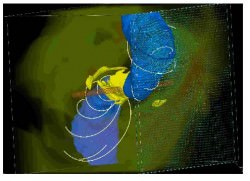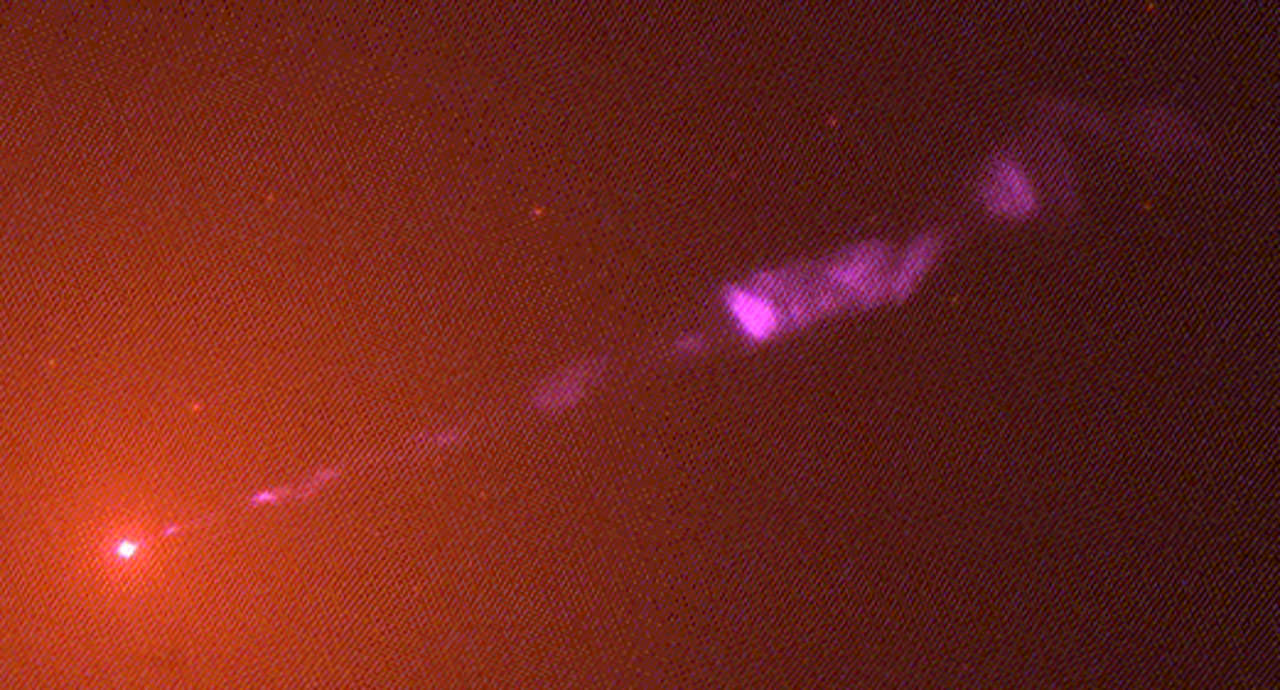Visible-light Hubble image of the jet emitted by the 3-billion-solar-mass black hole at the heart of galaxy M87 (Feb. 1998) Credit: NASA/ESA and John Biretta (STScI/JHU)
Even though black holes — by their definition and very nature — are the ultimate hoarders of the Universe, gathering and gobbling up matter and energy to the extent that not even light can escape their gravitational grip, they also often exhibit the odd behavior of flinging vast amounts of material away from them as well, in the form of jets that erupt hundreds of thousands — if not millions — of light-years out into space. These jets contain superheated plasma that didn’t make it past the black hole’s event horizon, but rather got “spun up” by its powerful gravity and intense rotation and ended up getting shot outwards as if from an enormous cosmic cannon.
The exact mechanisms of how this all works aren’t precisely known as black holes are notoriously tricky to observe, and one of the more perplexing aspects of the jetting behavior is why they always seem to be aligned with the rotational axis of the actively feeding black hole, as well as perpendicular to the accompanying accretion disk. Now, new research using advanced 3D computer models is supporting the idea that it’s the black holes’ ramped-up rotation rate combined with plasma’s magnetism that’s responsible for shaping the jets.
In a recent paper published in the journal Science, assistant professor at the University of Maryland Jonathan McKinney, Kavli Institute director Roger Blandford and Princeton University’s Alexander Tchekhovskoy report their findings made using computer simulations of the complex physics found in the vicinity of a feeding supermassive black hole. These GRMHD — which stands for General Relativistic Magnetohydrodynamic — computer sims follow the interactions of literally millions of particles under the influence of general relativity and the physics of relativistic magnetized plasmas… basically, the really super-hot stuff that’s found within a black hole’s accretion disk.
Read more: First Look at a Black Hole’s Feast
 What McKinney et al. found in their simulations was that no matter how they initially oriented the black hole’s jets, they always eventually ended up aligned with the rotational axis of the black hole itself — exactly what’s been found in real-world observations. The team found that this is caused by the magnetic field lines generated by the plasma getting twisted by the intense rotation of the black hole, thus gathering the plasma into narrow, focused jets aiming away from its spin axes — often at both poles.
What McKinney et al. found in their simulations was that no matter how they initially oriented the black hole’s jets, they always eventually ended up aligned with the rotational axis of the black hole itself — exactly what’s been found in real-world observations. The team found that this is caused by the magnetic field lines generated by the plasma getting twisted by the intense rotation of the black hole, thus gathering the plasma into narrow, focused jets aiming away from its spin axes — often at both poles.
At farther distances the influence of the black hole’s spin weakens and thus the jets may then begin to break apart or deviate from their initial paths — again, what has been seen in many observations.
This “magneto-spin alignment” mechanism, as the team calls it, appears to be most prevalent with active supermassive black holes whose accretion disk is more thick than thin — the result of having either a very high or very low rate of in-falling matter. This is the case with the giant elliptical galaxy M87, seen above, which exhibits a brilliant jet created by a 3-billion-solar-mass black hole at its center, as well as the much less massive 4-million-solar-mass SMBH at the center of our own galaxy, Sgr A*.
Read more: Milky Way’s Black Hole Shoots Out Brightest Flare Ever
Using these findings, future predictions can be better made concerning the behavior of accelerated matter falling into the heart of our galaxy.
Read more on the Kavli Institute’s news release here.
Inset image: Snapshot of a simulated black hole system. (McKinney et al.) Source: The Kavli Institute for Particle Astrophysics and Cosmology (KIPAC)

